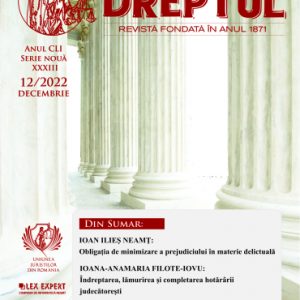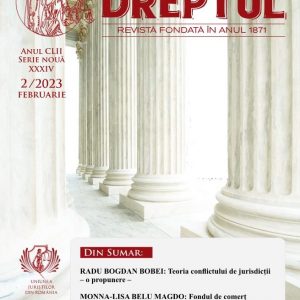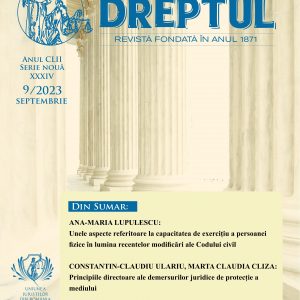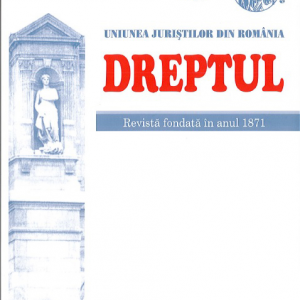-
 In this study the author analyzes the victim’s obligation to minimize the damage in the context of a hypothesis of tort civil liability. In this sense, after a short introductory part intended to set the framework of the analysis, the author proposes to identify what would be the normative provisions from which the victim’s obligation to minimize the damage would derive, emphasizing the fact that, despite the lack of a clear and unequivocal rule in this sense, the existence of the obligation still derives from a whole series of legal provisions. The particularities of the obligation to minimize the damage are further addressed, its general legal regime being decrypted, with emphasis on those aspects that distinguish and individualize it in relation to other legal institutions, but also its mode of operation. Likewise, the author aims to identify the legal nature of the obligation to minimize the damage, underlining the limits of the theses advanced so far and showing why the obligation is a sui generis one. Further on, there are emphasized the consequences produced by the obligation to minimize the damage, whether respected by the victim or not, and in the end there are presented brief considerations referring to his procedural regime.
In this study the author analyzes the victim’s obligation to minimize the damage in the context of a hypothesis of tort civil liability. In this sense, after a short introductory part intended to set the framework of the analysis, the author proposes to identify what would be the normative provisions from which the victim’s obligation to minimize the damage would derive, emphasizing the fact that, despite the lack of a clear and unequivocal rule in this sense, the existence of the obligation still derives from a whole series of legal provisions. The particularities of the obligation to minimize the damage are further addressed, its general legal regime being decrypted, with emphasis on those aspects that distinguish and individualize it in relation to other legal institutions, but also its mode of operation. Likewise, the author aims to identify the legal nature of the obligation to minimize the damage, underlining the limits of the theses advanced so far and showing why the obligation is a sui generis one. Further on, there are emphasized the consequences produced by the obligation to minimize the damage, whether respected by the victim or not, and in the end there are presented brief considerations referring to his procedural regime. -
 In this study, the author, emphasizing the difficulties encountered by judicial practice in the use, interpretation and application of law enforcement, clarification and completion of judgments, wishes to clarify these procedures, proposing some legislative changes to ensure clarity of incident rules. Thus, situations are presented in which, by means of a request for correction, misjudgments have been corrected, or both requests for clarification of the decision and a title appeal have been formulated, as well as doctrinal controversies regarding the right of option of the party between the procedure for completing the decision and the appeal for review.
In this study, the author, emphasizing the difficulties encountered by judicial practice in the use, interpretation and application of law enforcement, clarification and completion of judgments, wishes to clarify these procedures, proposing some legislative changes to ensure clarity of incident rules. Thus, situations are presented in which, by means of a request for correction, misjudgments have been corrected, or both requests for clarification of the decision and a title appeal have been formulated, as well as doctrinal controversies regarding the right of option of the party between the procedure for completing the decision and the appeal for review. -
 We are researching the mechanism of proof necessary for the application of the sanction of the automatic exclusion of statements obtained through torture or other ill -treatment contrary to Article 3 of the Convention. The topic has not yet been addressed in Romanian law, although it is of indisputable importance for the practical application of the sanction. Proof to a high standard of ill-treatment is essential to the normative force of the sanction. The difficulty of proving ill-treatment is the main impediment to its application in judicial practice. The resulting problem is solved by the European Court of Human Rights through a mechanism of proof that manages the legal consequences of uncertainty and does not lose sight of the requirement to find out the truth. This mechanism has three main components: The first is the requirement of an arguable claim about the ill-treatment, which is similar to the formal burden of proof (the burden of adducing evidence) in common law, with the difference that it is not imposed on a particular party, but is met if information about ill-treatment comes to the attention of the authorities in any way. The second is the obligation to effectively investigate this claim. The third is the substantial burden of proof or persuasive burden, which must be met to a certain standard of proof. Ill treatment must be proven by the party alleging it to the standard of proof beyond a reasonable doubt, but this standard can be met by corroborated presumptions. We present some typical presumptions applicable in situations frequently encountered in practice. Under Article 6 of the European Convention on Human Rights, the requirements of the fair trial may justify derogations from these general principles. For the automatic exclusion of statements, two cumulative conditions must be verified: the lack of an effective investigation and the real risk of ill-treatment.
We are researching the mechanism of proof necessary for the application of the sanction of the automatic exclusion of statements obtained through torture or other ill -treatment contrary to Article 3 of the Convention. The topic has not yet been addressed in Romanian law, although it is of indisputable importance for the practical application of the sanction. Proof to a high standard of ill-treatment is essential to the normative force of the sanction. The difficulty of proving ill-treatment is the main impediment to its application in judicial practice. The resulting problem is solved by the European Court of Human Rights through a mechanism of proof that manages the legal consequences of uncertainty and does not lose sight of the requirement to find out the truth. This mechanism has three main components: The first is the requirement of an arguable claim about the ill-treatment, which is similar to the formal burden of proof (the burden of adducing evidence) in common law, with the difference that it is not imposed on a particular party, but is met if information about ill-treatment comes to the attention of the authorities in any way. The second is the obligation to effectively investigate this claim. The third is the substantial burden of proof or persuasive burden, which must be met to a certain standard of proof. Ill treatment must be proven by the party alleging it to the standard of proof beyond a reasonable doubt, but this standard can be met by corroborated presumptions. We present some typical presumptions applicable in situations frequently encountered in practice. Under Article 6 of the European Convention on Human Rights, the requirements of the fair trial may justify derogations from these general principles. For the automatic exclusion of statements, two cumulative conditions must be verified: the lack of an effective investigation and the real risk of ill-treatment. -
 Pre-trial detention was defined as the most intrusive custodial preventive measure in the exercise of the person’s right to freedom, by which the judge or the court orders the detention of the defendant for the duration and under the specific conditions provided by law, in places specially intended for this purpose, in the interest of the criminal prosecution, the preliminary chamber procedure or the trial. In order to take pre-trial detention, it is necessary to meet all the general conditions provided by law for taking preventive measures, as well as the existence of at least one of the prev. of Article 223 of the Civil Procedure Code. In practice, in almost all cases, preventive arrest is based on the provisions of Article 223 (2) of the Civil Procedure Code. Under these conditions, we tried to create both a general presentation of these grounds and a theoretical analysis of the main issues that can generate confusion and problems in the application of the cases provided for by Article 223 (1) of the Civil Procedure Code. All this theoretical analysis has, as far as possible, been examined in conjunction with solutions from judicial practice, where appropriate.
Pre-trial detention was defined as the most intrusive custodial preventive measure in the exercise of the person’s right to freedom, by which the judge or the court orders the detention of the defendant for the duration and under the specific conditions provided by law, in places specially intended for this purpose, in the interest of the criminal prosecution, the preliminary chamber procedure or the trial. In order to take pre-trial detention, it is necessary to meet all the general conditions provided by law for taking preventive measures, as well as the existence of at least one of the prev. of Article 223 of the Civil Procedure Code. In practice, in almost all cases, preventive arrest is based on the provisions of Article 223 (2) of the Civil Procedure Code. Under these conditions, we tried to create both a general presentation of these grounds and a theoretical analysis of the main issues that can generate confusion and problems in the application of the cases provided for by Article 223 (1) of the Civil Procedure Code. All this theoretical analysis has, as far as possible, been examined in conjunction with solutions from judicial practice, where appropriate. -

-

-

-
 The content of the medical legal relation includes all rights and obligations of the provider and of the beneficiary of the medical service. Among these, only the rights of the patient benefit by an explicit and ample special regulation and by a growing doctrinal interest. However, this does not mean the lack of specific rights in favour of the doctor, but only the necessity to identify the existence and the determination of their content by analyzing the nature and/or the implicit effects of the legal provisions and of the jurisprudential solutions. Thus, the patient’s acceptance by the doctor, based on Article 663 (1) of the Law No 95/2006, is the equivalent of the informed consent of the patient, expressed pursuant to Articles 660–662 of the Law No 95/2006 and Articles 13–20 of the Law No 46/2003; the interruption of the relation between the doctor and the patient, pursuant to Article 664 (1) c) (ii) of the Law No 95/2006, as a result of a hostile and/or irreverent attitude towards the doctor, would be impossible in the absence of an obligation of gratitude of the patient, correlative to a right to gratitude of the doctor; and the jurisprudential consecration of the liability of the sanitary unit for the damage suffered by the doctor due to a nosocomial infection is due precisely to the existence of a right to security of the doctor.
The content of the medical legal relation includes all rights and obligations of the provider and of the beneficiary of the medical service. Among these, only the rights of the patient benefit by an explicit and ample special regulation and by a growing doctrinal interest. However, this does not mean the lack of specific rights in favour of the doctor, but only the necessity to identify the existence and the determination of their content by analyzing the nature and/or the implicit effects of the legal provisions and of the jurisprudential solutions. Thus, the patient’s acceptance by the doctor, based on Article 663 (1) of the Law No 95/2006, is the equivalent of the informed consent of the patient, expressed pursuant to Articles 660–662 of the Law No 95/2006 and Articles 13–20 of the Law No 46/2003; the interruption of the relation between the doctor and the patient, pursuant to Article 664 (1) c) (ii) of the Law No 95/2006, as a result of a hostile and/or irreverent attitude towards the doctor, would be impossible in the absence of an obligation of gratitude of the patient, correlative to a right to gratitude of the doctor; and the jurisprudential consecration of the liability of the sanitary unit for the damage suffered by the doctor due to a nosocomial infection is due precisely to the existence of a right to security of the doctor. -
 The relation between the civil servant and the public authority or institution in which he occupies the public office arises and is exercised on the basis of the unilateral administrative act of appointment, issued according to the legal provisions, and not by a contractual act. That is why the public function and the status of the civil servant have been regulated in the public law, separately from the labour relations specific to the private law, at the same time also determining the establishment of a specific sanctioning system, which takes into account the distinctive features of the way in which the public office is exercised. In this study there are analysed, from a dual perspective, theoretical and practical, the conditions of each form of the legal liability governed by the administrative law. At the same time, we also consider the cumulation of the disciplinary liability with other forms of legal liability of the civil servant for the damaging consequences of his deeds. A few aspects of novelty brought by the codification of the legislation on the liability of the civil servants in the Draft Administrative Code complete our research.
The relation between the civil servant and the public authority or institution in which he occupies the public office arises and is exercised on the basis of the unilateral administrative act of appointment, issued according to the legal provisions, and not by a contractual act. That is why the public function and the status of the civil servant have been regulated in the public law, separately from the labour relations specific to the private law, at the same time also determining the establishment of a specific sanctioning system, which takes into account the distinctive features of the way in which the public office is exercised. In this study there are analysed, from a dual perspective, theoretical and practical, the conditions of each form of the legal liability governed by the administrative law. At the same time, we also consider the cumulation of the disciplinary liability with other forms of legal liability of the civil servant for the damaging consequences of his deeds. A few aspects of novelty brought by the codification of the legislation on the liability of the civil servants in the Draft Administrative Code complete our research. -
 Unpaid community work has received multiple valences in the Romanian criminal law system, representing either an obligation in the content of the probation measures or a way of executing the penalty of the fine or an obligation that accompanies the abandonment of the criminal prosecution. The complexity of the institution, together with its novelty, has generated a series of difficulties including in respect of the performance of the unpaid community work, this article emphasizing some of these difficulties and proposing solutions for their removal.
Unpaid community work has received multiple valences in the Romanian criminal law system, representing either an obligation in the content of the probation measures or a way of executing the penalty of the fine or an obligation that accompanies the abandonment of the criminal prosecution. The complexity of the institution, together with its novelty, has generated a series of difficulties including in respect of the performance of the unpaid community work, this article emphasizing some of these difficulties and proposing solutions for their removal. -
 Cloud Computing is one of the most innovative technologies in the history of computing. It is radically changing the way how information technology services are created, delivered, accessed and managed. Cloud Computing enables the same services and user content to be delivered to any user device, whether a mobile phone, desktop or tablet computer. Cloud technology involves data storage at multiple data centers in different geographic locations. The evolution of computer technology is strongly related with the cybercrime phenomenon. Over the last decade, the number of crimes that involve computers and Internet has grown constantly. Criminal organizations try to be as efficient as possible and in order to make investigations difficult they are storing criminal data in foreign servers or in Cloud storage systems, and use cryptography and other data obfuscation techniques that hide their illicit activity. Cloud Computing offers criminals accessible means for committing cybercrime. In much the same way as cybercrime may be understood as a new way of committing traditional crimes such as fraud and theft, Cloud Computing presents criminals with new tools with which to commit these offences and many more. Researching this environment is a key element in understanding the new and more complex forms of cybercrime that occur today.
Cloud Computing is one of the most innovative technologies in the history of computing. It is radically changing the way how information technology services are created, delivered, accessed and managed. Cloud Computing enables the same services and user content to be delivered to any user device, whether a mobile phone, desktop or tablet computer. Cloud technology involves data storage at multiple data centers in different geographic locations. The evolution of computer technology is strongly related with the cybercrime phenomenon. Over the last decade, the number of crimes that involve computers and Internet has grown constantly. Criminal organizations try to be as efficient as possible and in order to make investigations difficult they are storing criminal data in foreign servers or in Cloud storage systems, and use cryptography and other data obfuscation techniques that hide their illicit activity. Cloud Computing offers criminals accessible means for committing cybercrime. In much the same way as cybercrime may be understood as a new way of committing traditional crimes such as fraud and theft, Cloud Computing presents criminals with new tools with which to commit these offences and many more. Researching this environment is a key element in understanding the new and more complex forms of cybercrime that occur today. -
 The provisions of Article 169 of the Law No 85/2014 on the procedures for preventing insolvency and for insolvency regulate the responsibility aimed at covering the debtor’s liabilities in case its assets do not satisfy all the claims of its debtors. The mentioned legal provisions regulate expressly determined cases in which either the members of the supervisory bodies, or the members of the management bodies of the legal person which is in a state of insolvency or any other person that has caused the state of insolvency may be obliged to cover a part of the liabilities of the insolvent debtor, provided that the activity they carried out has led to the insufficiency of the available cash funds from the patrimony of the debtor legal person. In relation to the provisions of Article 171 of the mentioned normative act, the responsibility of the specified persons may be engaged in any form of the procedure, either in judicial reorganization, or in bankruptcy. In case of judicial reorganization, the amounts of money obtained as a result of the responsibility of the mentioned persons are intended to supplement the funds necessary for the continuation of the debtor’s activity, and, in case of bankruptcy, those amounts must ensure that the debtor’s liabilities are covered. The regulation of the responsibility of the members of the supervisory/management bodies or of any other person that has caused the state of insolvency of the debtor legal person is an integral part of the procedure provided by the law on insolvency.
The provisions of Article 169 of the Law No 85/2014 on the procedures for preventing insolvency and for insolvency regulate the responsibility aimed at covering the debtor’s liabilities in case its assets do not satisfy all the claims of its debtors. The mentioned legal provisions regulate expressly determined cases in which either the members of the supervisory bodies, or the members of the management bodies of the legal person which is in a state of insolvency or any other person that has caused the state of insolvency may be obliged to cover a part of the liabilities of the insolvent debtor, provided that the activity they carried out has led to the insufficiency of the available cash funds from the patrimony of the debtor legal person. In relation to the provisions of Article 171 of the mentioned normative act, the responsibility of the specified persons may be engaged in any form of the procedure, either in judicial reorganization, or in bankruptcy. In case of judicial reorganization, the amounts of money obtained as a result of the responsibility of the mentioned persons are intended to supplement the funds necessary for the continuation of the debtor’s activity, and, in case of bankruptcy, those amounts must ensure that the debtor’s liabilities are covered. The regulation of the responsibility of the members of the supervisory/management bodies or of any other person that has caused the state of insolvency of the debtor legal person is an integral part of the procedure provided by the law on insolvency.
